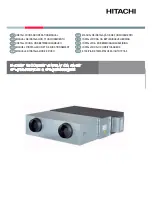
Centrifugal, Industrial and Filtered Supply
11
Belt Drive Maintenance
V-belt drives must be checked on a regular basis
for wear, tension, alignment and dirt accumulation.
Premature or frequent belt failures can be caused by
improper belt tension, (either too loose or too tight)
or misaligned sheaves. Abnormally high belt tension
or drive misalignment will cause excessive bearing
loads and may result in failure of the fan and/or motor
bearings. Conversely, loose belts will cause squealing
on start-up, excessive belt flutter, slippage, and
overheated sheaves. Either excessively loose or tight
belts may cause fan vibration.
When replacing V-belts on multiple groove drives all
belts should be changed to provide uniform drive
loading. Use a set of matched belts whenever possible.
Do not pry belts on or off the sheave. Loosen belt
tension until belts can be removed by simply lifting
the belts off the
sheaves.
After replacing
belts, insure that
slack in each belt
is on the same
side of the drive.
Belt dressing
should never be
used.
Do not install new belts on worn sheaves. If the sheaves
have grooves worn in them, they must be replaced
before new belts are installed.
The proper tension for operating a V-belt drive is the
lowest tension at which the belts will not slip at peak
load conditions. For more information about measuring
belt tension, refer to Greenheck’s Product Application
Guide, FA/127-11, Measuring Belt Tension, found online
at greenheck.com in the Resources section.
Check belt tension before start up and after the first
24 hours of operation. The belt tension should also be
checked periodically thereafter.
Improper sheave
alignment
Proper sheave
alignment
Deflection =
Belt Span
64
Belt Span
WARNING
Do not overtighten belts. Excessive belt tension can
lead to premature belt and/or bearing failure.
Belt Adjustment
Belts on model IP are adjusted from the exterior of the
fan. Covers should be opened or removed so the belt(s)
can be inspected and checked for proper tension.
The tension of the belt(s) are adjusted by raising and
lowering the motor plate. There are bolts on each side of
the fan that must be used in order to adjust the belt(s).
Each side has two plate bolts and two L-adjustment
bolts.
1. Loosen, but DO NOT remove the two plate bolts on
each side of the motor plate.
2. Loosen, then adjust the L-bolts to raise or lower
the motor in order to tighten or loosen the belt(s) as
needed. The nuts on the L-adjustment bolts should
be adjusted evenly so the motor plate is raised or
lowered as level as possible.
3. Tighten all the L-adjustment bolts and the plate
bolts to lock motor in place after proper tension is
reached.
NOTE
Loosen the plate bolts as minimal as possible to
allow the plate to move, but so the plate has minimal
movement when bolts are re-tightened.
WARNING
Be sure to raise or lower the motor plate as even as
possible for proper belt engagement and to avoid
jamming the plate.
L-Adjustment
Bolts
Plate Bolts


































